Since I was a young child Mars held a special fascination for me. It was so close and yet so faraway. I have never doubted that it once had advanced life and still has remnants of that life now. I am a dedicated member of the Mars Society,Norcal Mars Society National Space Society, Planetary Society, And the SETI Institute. I am a supporter of Explore Mars, Inc. I'm a great admirer of Elon Musk and SpaceX. I have a strong feeling that Space X will send a human to Mars first.
Tuesday, May 31, 2022
Sunday, May 29, 2022
Finding And Communicating With E.T.
Today I get
to talk about a subject near and dear to my heart-life on other planets and
moons. I have no doubt that life existed on Mars and still exists underground
today. I feel that advanced and intelligent life once existed on Mars. Why
don't we see ruins of cities from long ago? It is because this advanced life
lived in caves and underground structures.
I also believe that a group of meteors from
Mars launched life on our planet. Whatever life we find on Mars will have a lot
of similarities to life on earth.
Intelligent life could have taken
infinite possibilities when we go further out in our solar system and to
planets in other galaxies. How do we recognize it and communicate with it?
Some astrophysicists have come up with
some "think outside the box" ideas published in The Economist
magazine this week. I will share these with you now:
How to
improve the search for aliens
So far,
people have sought Earthlike biology. That will change
May 25th
2022 (Updated May 26th 2022)
Share
Give
For decades,
astronomers searching for life beyond humanity’s home planet have had a simple
strategy: follow the water. Water is the sine qua non of terrestrial life and
as thousands of new planets have been discovered orbiting faraway stars, the
greatest levels of excitement have usually been reserved for those in the
“habitable zones” of their systems—in other words orbiting at a distance where
liquid water could exist on the planet’s surface.
Listen to
this story. Enjoy more audio and podcasts on iOS or Android.
The next
step has been to look for biosignatures—molecules which might betray the
existence of biological processes. These could include oxygen or methane in a
planet’s atmosphere. On Earth, those molecules persist only because living
things constantly regenerate them.
The problem
with both these approaches is obvious—they are restricted to finding life as
currently known. But, as Natalie Grefenstette, an astrobiologist at the Santa
Fe Institute in New Mexico, points out, “we don’t know if other forms of life
would necessarily have the same signatures, if they would have the same
metabolisms, if they would be based on the same genetic molecules or any of the
same molecules at all.” Life on Earth could have evolved in the way that it has
because the specific chemistry of the planet at crucial times gave rise to
selective pressures which might not be present on other worlds. “And so we’ve
been thinking—if life were different, how do you even look for that?”
Exotic
beasts and how to find them
From May
16th-20th, at AbSciCon, a biennial astrobiology meeting organised by the
American Geophysical Union and held this time around in Atlanta, Georgia,
astrobiologists including Dr Grefenstette considered that question and
discussed ways to expand their searches in the coming decades, so that they
might stand a better chance of recognising more exotic forms of life than are
currently being sought. To do this, they will need several strategies.
The first
begins by imagining the various different chemistries which exotic forms of
life might employ, and using those to devise a wider set of potential
biosignatures. On Earth, the most important molecules of life almost all
involve carbon atoms. These are particularly versatile because they can form
chemical bonds with up to four other atoms, including other carbons, to create
complex molecular structures. Carbon is the fourth most abundant element in the
universe and the molecules it forms can survive for long periods in the sorts
of temperatures and pressures found on Earth’s surface.
An exotic
lifeform might plausibly, however, rely on silicon instead of carbon. Silicon
sits just underneath carbon in the periodic table and thus shares with it the
ability to bond with up to four other atoms. Familiar examples of the results
are most of the huge diversity of minerals which make up rocks, for silicon is
the second most common element in Earth’s crust. It is also the seventh most
abundant in the universe, which means there is plenty of it available for
potential silicon-based lifeforms to use.
Alien life
might, though, have its roots in something yet more exotic. In the laboratory,
metal oxides known as polyoxymetalates have shown some remarkably lifelike
abilities, such as being able to form membranes (dubbed “inorganic chemical
cells” by Lee Cronin, a chemist at the University of Glasgow) and being able to
assemble, with some chemical help, into complex structures reminiscent of dna.
Whatever its
building blocks, though, life will need a solvent in which to function. On
Earth, that solvent is water.
Water is a
good solvent because it is a “polar” molecule, meaning its electrical charge is
unevenly distributed. In a molecule of H2O the oxygen has a slightly negative
charge and the two hydrogen atoms are, by way of counterbalance, slightly
positive. This polarity causes water molecules to stick to similarly polar
molecules, making them good at dissolving other chemicals—which, in turn, once
thus in solution, can interact with each other. That enables water to support
the myriad functions of life, and no other abundant chemical on Earth matches
this versatility.
Other
chemicals can, however, fulfil some of the roles water plays. Life elsewhere
might, perhaps, have found a way to employ ammonia. This, like water, is polar,
and therefore good at dissolving things. It is not quite as good at doing so as
water, though, and it also stays liquid (at terrestrial atmospheric pressures,
at least) only between -78°C and -33°C. But that would make it available in
liquid form in frigid places such as Europa, a moon of Jupiter, and Titan and
Enceladus, moons of Saturn, where water itself would be frozen.
Possible
solutions
Titan in
particular is believed to host vast ammonia-rich underground lakes which might
act as cradles for chemically exotic life. But other possibilities exist there,
too. Dr Grefenstette says astrobiologists are also intrigued by the lakes of
liquid methane that cover Titan’s surface (the average temperature of which is
-179°C). Methane exists on the surface of Titan in much the same way that water
does on Earth—in liquid, gaseous and solid forms.
Methane is
not a perfect solvent for life. It is not polar and therefore not as versatile
in that regard as water. And it remains liquid (again, at terrestrial
atmospheric pressures) only between -182°C and -161°C. Since chemical reactions
proceed more rapidly at higher temperatures, on Titan’s surface they would be
pretty slow. But astrobiologists hypothesise that life composed of different
materials to those on Earth—smaller hydrocarbons and nitrogen, for
example—could feasibly eke out an existence there.
Perhaps the
most promising general-purpose alternative to water is formamide, a colourless
organic liquid composed of carbon, hydrogen, oxygen and nitrogen (all elements
common in the universe) that can dissolve many of the same chemicals as
water—including proteins and dna. It can also stay liquid at up to 210°C,
making possible a large range of chemical reactions on planets with more
extreme surface temperatures than Earth’s. Formamide is such an intriguing
alternative to water that some astrobiologists even argue that it might have
been the main solvent used by the earliest forms of terrestrial life. This
chemical has been located in vast clouds at the edge of the solar system and
also in more distant nebulae where stars are forming, according to Claudio
Codella, an astronomer at the Arcetri Astrophysical Observatory in Florence,
Italy. Finding it definitively on another world would surely pique interest
among those searching for exotic forms of life.
The units of
life on Earth—cells—are contained within lipid membranes. These keep the
chemical reactions which sustain life concentrated inside a cell, and the
exterior world outside it. Such membranes would not be stable in a medium such
as liquid methane. But exotic lifeforms on Titan might instead build membranes
from structures called azotozomes. These are molecules, currently hypothetical,
made from nitrogen-rich organic compounds, according to Paulette Clancy, a
chemist at Cornell University who came up with the idea. They would, she
thinks, be capable of operating in the ultra-low temperatures of a place like
Titan.
Or perhaps
there could be life without any membranes at all. Lifelike chemical reactions
have been shown to occur on the surfaces of certain minerals, including pyrites
and various clays. These often contain networks of pores and cavities that
could serve the compartmentalising function of lipid-based cells. Or biological
reactions might be contained within drops of liquid floating in planetary
atmospheres.
Finally,
life needs to store information about itself and pass that information on to
its offspring. Terrestrial organisms do this using molecules called nucleic
acids. These employ four different molecular units known as nucleotides to
carry a code of instructions that can build 20 different amino acids, which
then link up in various combinations to form proteins. But laboratory
experiments and samples from meteorites show that many more nucleotides and
amino acids than these exist. Though they have not been incorporated into life
on Earth, they could form the basis of alternative systems of genetic
information.
Identifying
exotic life forms made from different materials is thus a matter of widening
the search from Earthly biosignatures—oxygen, methane and so on—to include
chemicals that might be made by various imagined biochemical systems. One tool
for this search is the mass spectrometer, a device that ionises samples and
then filters those ions by mass.
Mass action
Mass
spectrometers have been the eyes and ears of decades of space exploration, said
Luoth Chou, an astrobiologist at Georgetown University. Successive generations
of these devices, flown into space, have permitted researchers to characterise
chemicals everywhere from the surface of Mars, via the atmospheres of Venus and
Titan, to the plumes of water ejected from geysers on Enceladus.
The next
generation of mass spectrometers, though, will be smaller and yet more
powerful. And they will be carried aboard a range of missions far and wide into
the solar system. Dragonfly will hop around the surface of Titan in the
mid-2030s and take a close-up look at the molecules there. davinci will orbit
Venus in 2031. The Jupiter Icy Moons Explorer will explore the Jovian satellite
system, starting in the early 2030s. And Europa Clipper’s mass spectrometer
will provide a high-resolution characterisation of that body, beginning at the
end of this decade.
If exotic
life does exist, however, it could use chemistry that goes way beyond anything
astrobiologists can currently imagine. To get around that means thinking of
biosignatures which depend not on chemistry but rather on the patterns of
behaviour associated with life.
There is no
universal definition of life. But astrobiologists often default to nasa’s
operational definition of “a self-sustaining chemical system capable of
Darwinian evolution”. Living things self-replicate and make large amounts of
specific complex molecules (for example, proteins or dna). They also draw
energy and consume resources from their environments to fuel their metabolisms.
Based on these ideas, so-called agnostic biosignatures could include looking
for excesses in certain elements or isotopes in an environment, or for specific
patterns within groups of chemicals that cannot be explained by abiotic
processes alone. Peter Girguis, an evolutionary biologist at Harvard
University, told the AbSciCon meeting that this new class of biosignatures
would be “indirect proxies for a living organism”.
One example
would be to search for gradients in an environment—zones of sharp change in,
for example, heat or electrical voltage or chemicals. According to Dr Girguis,
“all living organisms that we know of establish gradients of one kind or
another to maintain themselves at a kind of disequilibrium from the
environment.”
Some of
these gradients occur at cellular and microscopic scales, and can be incredibly
sharp and therefore distinguishable from non-biological processes. Others are
larger-scale. In marine sediments on Earth, for example, microbes work together
to oxidise methane, a process tied to the chemical reduction of sulphate ions.
“We see gradients in methane and sulphate concentration over centimetres, and
they’re really pronounced,” says Dr Girguis. “This is a biological
manifestation of their activity and yet this is detectable by simply making
abiotic measurements.”
Another
tactic would be to study the complexity of the molecules at a particular
location. Biological molecules are selected and shaped by evolution to do
specific jobs within an organism, such as assembling or disassembling other
molecules, or signalling between cells. That often requires unusually energetic
chemical processes, which in turn need the help of catalysts. On Earth, these
catalysts are protein molecules called enzymes which are, themselves, the
product of evolution. Finding complex molecules of any sort might thus be
considered a potential biosignature.
A related
concept is what Chris McKay, a planetary scientist at nasa Ames Research
Centre, calls the “Lego principle”. The idea here is that life is recognisable
by its use and reuse of a selected set of molecules. Abiotic samples scooped up
from an alien world would be expected to contain a wide array of organic molecules,
some of them in fairly small amounts. A biological sample, by contrast, would
contain large numbers of just a few distinctive molecules. Molecules that are
chemically similar (left-handed and right-handed versions of an amino acid, for
example) might have markedly different concentrations if they came from a
biological sample, whereas they would probably be present in near-equal numbers
in a non-biological one. Spotting patterns like these would be independent of
the specific biochemistry involved.
The past as
a clue to the present
Such methods
would widen the astrobiological search wherever it was possible to obtain a
sample—in other words any world in the solar system to which researchers can
send a probe—and apply to it tools such as miniaturised, space-hardened mass
spectrometers. For planets going around other stars, though, things are
obviously trickier. Few people think human beings or their machines will visit
any of the rapidly expanding population of these exoplanets anytime soon.
Astrobiologists are instead considering other ways to search for new agnostic
biosignatures. Michael Wong, an astrobiologist at the Carnegie Institution for
Science, in Washington, dc, presented a technique that applies what is known as
network science to data about exoplanets’ atmospheres. These data can be
gathered using telescopes on, or orbiting, Earth.
Any chemical
system, the chemicals within an atmosphere included, can be represented by a
so-called network diagram, in which molecules that react with each other in
some way are connected by lines. Dr Wong showed that, when compared with those
of other planets in the solar system, Earth’s atmospheric network stands out
like a sore thumb. In fact Earth’s network more closely resembles those of
biological systems, such as marine food webs. This technique is a work in
progress and Dr Wong said it would need a lot more development before
astrobiologists could include it in their life-detection toolkit. But it is an
intriguing approach.
Dr Girguis
told the meeting that future searches for exotic life in the universe would do
well to learn from mistakes made by explorers searching for life in Earth’s
oceans in the 19th century. In one expedition, for example, Edward Forbes, a
prominent naturalist from the Isle of Man, was dredging in the Aegean Sea. He
noticed that the farther plants and animals were from the water’s surface, the
less well they thrived. In 1843 he extrapolated his incomplete data to propose
his azoic hypothesis, which stated that life would not exist at all below 550
metres.
It took
several decades to prove him wrong, an effort that involved some of the first
scientific endeavours designed to explore the deep ocean—such as the Challenger
expedition that sailed from 1872 to 1876. These, said Dr Girguis, were some of
humanity’s earliest life-detection missions. “Let’s not be too quick to
extrapolate,” he warned his fellow astrobiologists. “And let’s never
underestimate the capacity of living organisms.” ■
Curious
about the world? To enjoy our mind-expanding science coverage, sign up to
Simply Science, our weekly newsletter.
This article
appeared in the Science & technology section of the print edition under the
headline "Life, but not as we know it"
Science
& technology
May 27th
2022
Saturday, May 28, 2022
Friday, May 27, 2022
A Review Of Space Forces
 |
Review: Space Forces
by Jeff Foust
Monday, May 23, 2022
Space Forces: A Critical History of Life in Outer Space
by Fred Scharmen
Verso, 2021
hardcover, 272 pp.
ISBN 978-1-78663
US$26.95
Later this week, space enthusiasts will gather in Crystal City, Virginia—a mystical name for a mundane neighborhood of commercial and residential high-rises near Washington’s Reagan National Airport—for the National Space Society’s International Space Development Conference (ISDC), the first in-person edition of the conference since 2019. As in past years, this year’s ISDC will have a track on space settlement, along with a student space settlement competition and a new “Rothblatt Space Settlement in Our Lifetime Prize Business Plan Competition.” (The conference also includes tracks on space elevators and space solar power, completing the holy trinity of unrealized but unwavering dreams of space advocates.)
Much of those discussions will focus on the how of space settlement (farming is one particular focus area) but less about the why of space settlement: why do some people want to live in space, a far more hostile environment than even the most inhospitable places on Earth? That’s a question that Fred Scharmen grapples with in Space Forces, a book that offers a historical and philosophical view of various visions of humanity living beyond Earth.
| “Whether or not the dream of successful permanent life in space is eventually assured, it seems inevitable that people will continue to try and make that future happen,” he concludes. |
The visions of space colonies espoused by Gerard K. O’Neill a half-century ago, the start of a through line that extends to the ISDC space settlement sessions today, is one chapter of the book. Scharmen looks at other views of space settlement, such as in the fiction and non-fiction of Arthur C. Clarke and Wernher von Braun. He goes back even earlier, to writings by Konstantin Tsiolkovsky that was infused with the “cosmism” school of thought of the early 20th century that sought to optimize the universe for humanity, as well as J.D. Bernal, the British scientist who proposed space settlements in the 1920s.
The book’s final chapter looks at the present day and the two billionaires with their own different visions of space settlement: Jeff Bezos, who seeks to breathe new life into O’Neill’s vision of space settlements in free space; and Elon Musk, who continues to focus on settlements on Mars. Both visions motivate their employees and supporters, even if realizing them is still far in the future.
He offers an interesting comparison of the two: “Where Bezos takes apart whole industries and whole worlds, putting them back together in ways that suit his company’s needs—and sometimes with disruptive results in the world outside—Musk will simply make a version of the thing that is more efficient, more cost-effective, and cleaner—without requiring any massive change to lifestyles or the status quo.” While that may apply to other industries, it’s not clear it’s applicable to space. Bezos has, so far, done little to take apart the space industry, as Blue Origin moves as a glacial pace compared to Musk’s SpaceX. And while SpaceX’s Falcon 9 is, in some respects, a more cost-effective replacement to existing launch vehicles, that assessment overlooks the disruptive capabilities of rocket reusability, not to mention the industry-reshaping Starlink constellation and Starship vehicle.
Scharmen views all of these with a skeptical eye, unconvinced of their motivations, particularly those based on economic rationales: “If existing economic structures that maximize return on investment are extended into space, capitalism will need someone with desires and needs to exploit.” However, he doesn’t expect anything he writes to change that. “Whether or not the dream of successful permanent life in space is eventually assured, it seems inevitable that people will continue to try and make that future happen.”
There is not much organized opposition to space settlement. Scharmen mentions a 2019 conference in Seattle called the Salish Sea Anti-Space Symposium that the backers described as “a first of its kind event to say NO TO SPACE EXPLOITATION!” that he describes as an opportunity to critique not just Bezos and Musk “but the idea of space travel and space settlement altogether.” The event’s website, preserved since that 2019 event (first and only of its kind, perhaps), includes an illustration of a person stabbing an astronaut in the back of his helmet, air whooshing out, with the words “Don’t Let ’Em Leave”. Scharmen doesn’t mention this violent imagery or the topics discussed at event, including one speaker who gave a talk on “how A Conspiracy of Witches has been hidden in plain site, [sic] culminating in participation in the Apollo Mission, a sacred journey for practitioners of secret female technologies.” It’s hard to take such critics seriously, but perhaps movements get the critics they deserve.
This week’s ISDC won’t be just about space settlement and other long-term visions. There will be talks about nearer-term activities, including efforts to develop commercial space stations by the end of the decade to succeed the International Space Station—not exactly a O’Neillian settlement at L5, but something more realistic for the foreseeable future, if still challenging. Space advocates will continue to dream of crystal cities in space, but for now may have to settle for a studio apartment with a view.
Jeff Foust (jeff@thespacereview.com) is the editor and publisher of The Space Review, and a senior staff writer with SpaceNews. He also operates the Spacetoday.net web site. Views and opinions expressed in this article are those of the author alone.
Note: we are using a new commenting system, which may require you to create a new account.
Barnstorming The Moon
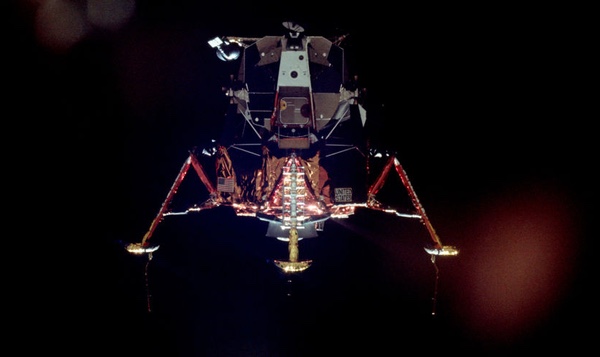 Early in the Apollo program, NASA considered converting the Lunar Module into a reconnaissance spacecraft to scout landing sites. (credit: NASA) |
Barnstorming the Moon: the LEM Reconnaissance Module
by Philip Horzempa
Monday, May 23, 2022
The Recon LEM mission was designed to scout landing sites for Project Apollo. At that time, nothing was known of the small-scale characteristics of the Moon’s surface. We had no idea if there would be areas smooth enough to allow a landing by Apollo’s Lunar Module. Gaining that information was just as critical as building the machines that would land a pair of astronauts on the Moon. This was the first time that humanity needed to get serious about certifying landing zones on an alien world. But, how to do that?
| The key element in the Grumman proposal was the LEM and the suite of cameras that it would carry in a payload module attached to the Ascent Stage. Equally important, the Recon LEM would carry a bevy of landing probes. |
In an effort to find out, NASA issued a request for proposals (RFP), specifically MSC-63-624P, titled “Reconnaissance System Study for Manned Lunar Missions.” In response, the Grumman Aircraft company in September 1963 put forth a proposal that would use their LEM (Lunar Excursion Module) for this task.[1] The modified craft, hereinafter referred to as the Recon LEM, would survey candidate sites with a suite of cameras packed in a dedicated module.
Another option for site verification was the Lunar Mapping & Survey System (LMSS) project (see “Project Upward: hauling the NRO’s GAMBIT to the Moon”, The Space Review, September 15, 2014). The LMSS was a joint project between NASA and the NRO with the classified name of Upward. It was designed to carry Kodak’s KH-7 camera either in the Apollo Service Module or in a modified Gambit satellite docked to the Command Module
By contrast, Grumman’s Recon LEM would become a free-flyer once it arrived in lunar orbit. The LEM was ideal for this mission, able to change its orbital altitude and inclination with ease. After undocking from the Apollo Command Module (CM), it would use its Descent Propulsion System (DPS) to enter an orbit that dipped as low as eight nautical miles (15 kilometers) above the lunar surface.
The key element in the Grumman proposal was the LEM and the suite of cameras that it would carry in a payload module attached to the Ascent Stage. Equally important, the Recon LEM would carry a bevy of landing probes. These craft would alight on the Moon’s surface, providing ground truth on the nature of candidate sites. The goal of the Recon LEM was obtaining the required reconnaissance data during a very compressed timeline. The longest proposed mission spanned two days in orbit, while the shortest completed its mission within five lunar orbits, or 10 hours. It was vital to get some amount of detailed data, even if all of the target sites could not be surveyed. Some information, on some sites, would be a gold mine compared with the utter lack of knowledge at that time.
A secondary goal was wide-area mapping of the Moon. The best resolution from Earth-based telescopes was on the order of several hundred feet (hundreds of meters). To better understand the Moon, maps with a resolution of tens of feet (several meters) were required. The cartographic camera onboard the Recon LEM could provide the photos needed to create those maps. The basic game plan was for the Recon LEM to undock from the CSM (Command and Service Modules) and transfer to lower-altitude orbits. This would enable the highest resolution for the photographic surveys.
Equally important as photography was the payload of Drop Probes. As it barnstormed the Moon, the Recon LEM would drop these small landers at potential Apollo sites. Several thousand kilograms of probes were attached to the LEM Descent Stage and they were designed to survive either a soft or hard landing. Their main mission was on-site certification of a landing area. The secondary function of the probes was their use as landing beacons for a LEM. It was felt that smooth, safe patches of terrain might be scarce. If a lander was able to certify a site, then its onboard beacon would guide the LEM to what could be a patch of ground only a few hundred feet (about a hundred meters) in diameter. A beacon would provide the guidance required to steer a descending LEM away from hazardous terrain.
| The Recon LEM, in some ways, was more akin to a reconnaissance aircraft. The sporty, lightweight LEM was able to survey sites on the Moon from altitudes at which the U-2 flew over the Earth. |
During this era, Grumman had proposed modifying the LEM for a variety of missions. Its design was inherently flexible, allowing it to serve as a lunar taxi, high Earth orbit relay satellite, or a lunar shelter. In the end, the only project to use a modified LEM was the Apollo Telescope Mount (ATM) project. However, even that effort was later dropped when the ATM design was modified to be launched as an integral part of the Skylab orbital workshop.
For the mission to survey the Moon, a payload bay carrying the survey cameras was attached to the top of the Lunar Excursion Module. This section was pressurized and could be accessed by opening the top hatch of the Ascent Stage. A new hatch was located in the top of the instrument module to allow normal docking with the Apollo CM.
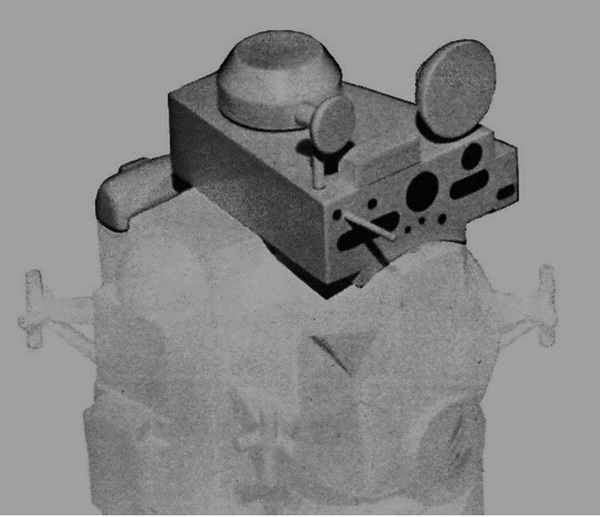 Instrument Module atop the LEM (credit: Grumman Aerospace) |
In this view, the rendezvous radar antenna has been relocated atop the recon package. It is the smaller of the two antennas, with the larger one designed for radar scans of the Moon.
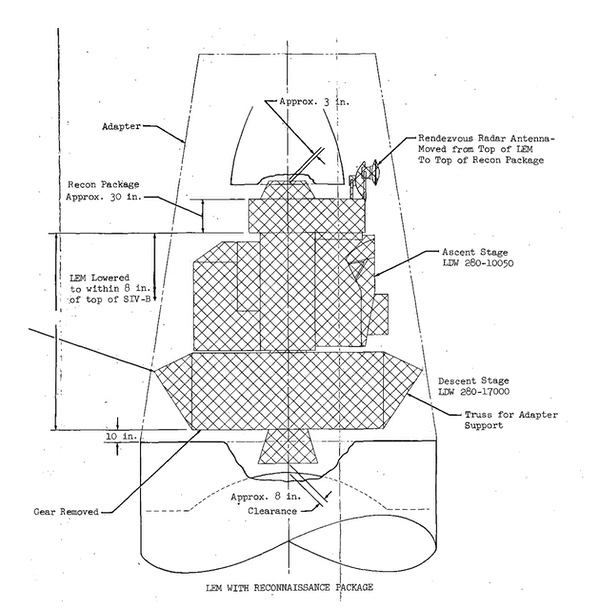 |
This diagram illustrates how the modified LEM could be accomodated within the existing SLA (Saturn LEM Adapter). The Recon Bay atop the LEM Ascent Stage would normally crowd the Service Module SPS engine bell. However, the omission of landing legs allowed the vehicle to be lowered succificiently to overcome that packaging problem.
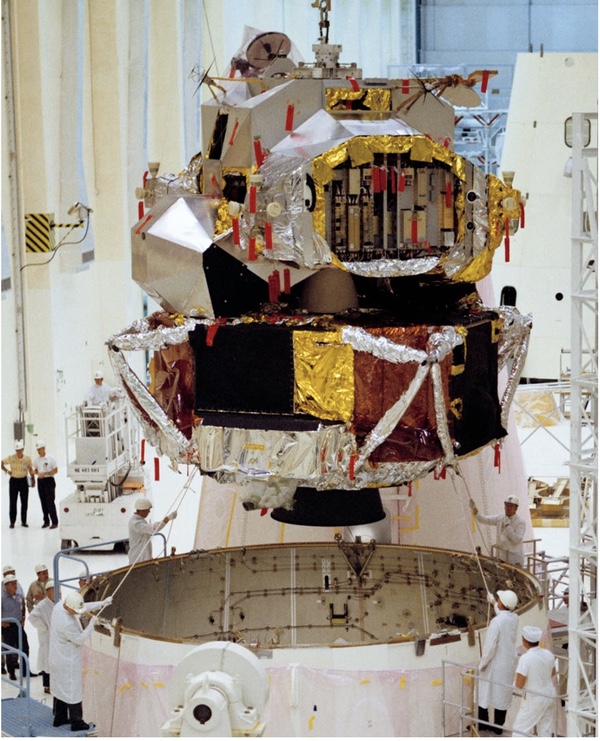 Lunar Module and lower section of SLA (credit: NASA) |
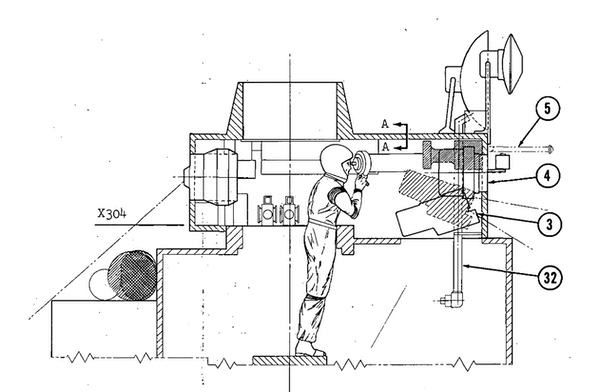 (credit: Grumman Aerospace) |
A variety of cameras were carried in the Recon module. In this diagram, an astronaut is “standing” on the Ascent Engine cover while his upper body is inside the payload module. He is shown using the spotting telescope equipped with a camera. To quote the Grumman report: “The 48 in. camera and telescope combination would be the primary site verification instrument on board. With it, a crewman can inspect the terrain for interesting features during a low-altitude pass, zoom the eyepiece to higher power at particular points, and record the image with the camera.”
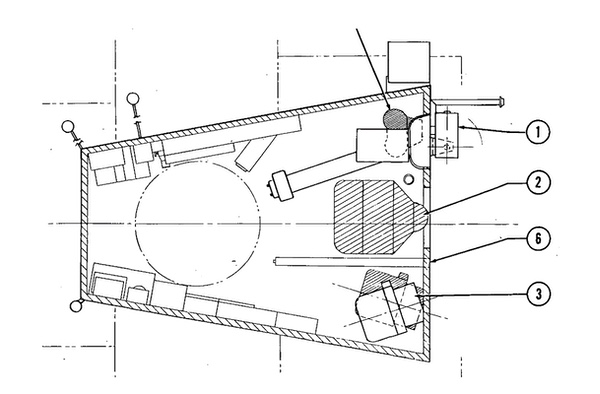 (credit: Grumman Aerospace) |
The array of cameras are indicated in this overhead view. The large circle to the left is the hatch that led to the Ascent Stage. Camera #1 is the spotting telescope. Device #2 is a large panoramic camera with a suggested focal length of 24 inches (60 centimeters). It could produce high-resolution photographs with a wide field of view. Device #6 is a wide-angle viewfinder, while #3 is a cartographic camera with a focal length of six inches (15 centimeters) and a nine-by-nine-inch (23-by-23-centimeter) film format.
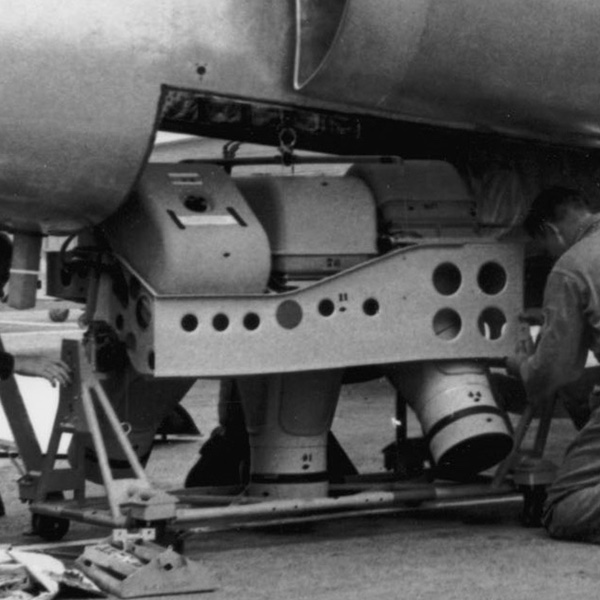 U-2 Camera Payload (credit: Department of Defense) |
The Recon LEM, in some ways, was more akin to a reconnaissance aircraft. The sporty, lightweight LEM was able to survey sites on the Moon from altitudes at which the U-2 flew over the Earth. The Grumman report mentions a 24-inch (60-centimeter) focal length camera, but provides no additional details. However, the reconnaissance camera onboard the U-2 spy plane may have been a candidate for that role. In fact, the outline in the Grumman report bears some resemblance to that used on the U-2.
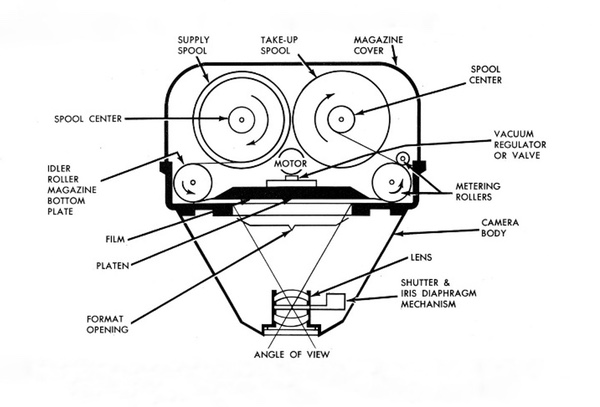 U-2 camera; 24-inch focal length (credit: United States Air Force) |
At an altitude of 15 nautical miles (28 kilometers), the U-2 camera had a resolution of 2.5 feet (0.8 meters). At the Recon LEM’s closest approach of eight nautical miles (15 kilometers), this camera was close to providing Grumman’s resolution goal of one foot (30 centimeters) for the Apollo site survey.
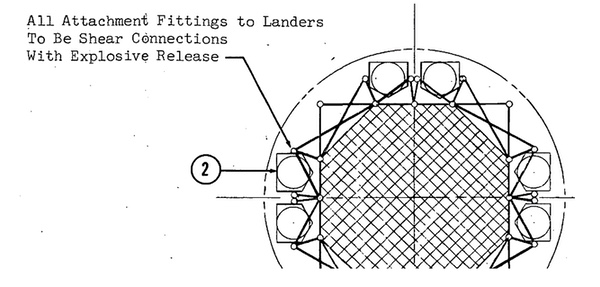 Probe Placement and Deployment Mechanism (source: Grumman Aerospace) |
Probes and beacons
The mission of the Recon LEM included deploying small landers at each candidate site. There were four types of probes, with weights ranging from 400 to 1,000 pounds (180 to 450 kilograms). The Grumman report provides few details of these devices and their payloads. It does list the two categories of data needed to verify a site, i.e., surface bearing strength and roughness of terrain.
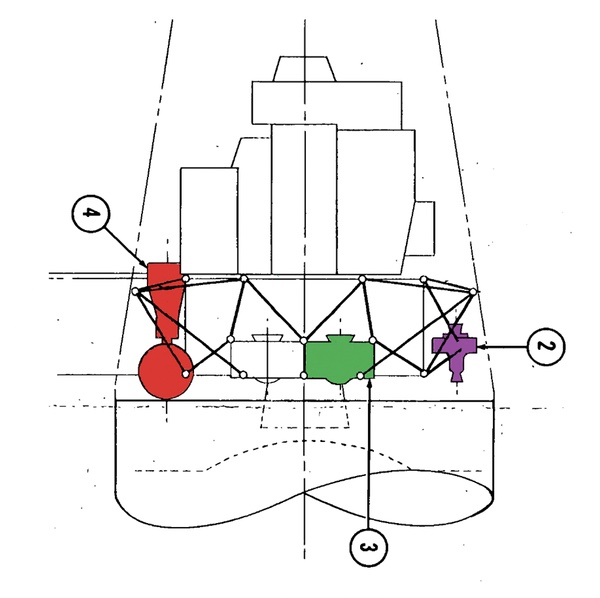 |
This color-coded diagram highlights the various classes of Probe designs. There were 4 designs in total, and this illustrates how they would be attached to the LEM Descent Stage.
Probe 1: Soft Lander, 1,050 lbs. (475 kg)
Probe 2: Semi Soft Lander, 300 lbs. (135 kg)
Probe 3: Hard Lander, 850 lbs. (385 kg)
Probe 4: Hard Lander, 425 lbs. (190 kg)
The main goal of these probes was to verify, from the surface, the suitability of sites for Apollo landings. To quote the Grumman report: “Potential probe designs… can range from simple unguided hard-landers to sophisticated soft-landers with inertial platform guidance systems, with a corresponding increase in landing accuracy.” The report points out that the “actual number carried would be a function of the size and weight of the selected probe; however it appears that eight hard-landers can be easily accomodated.”
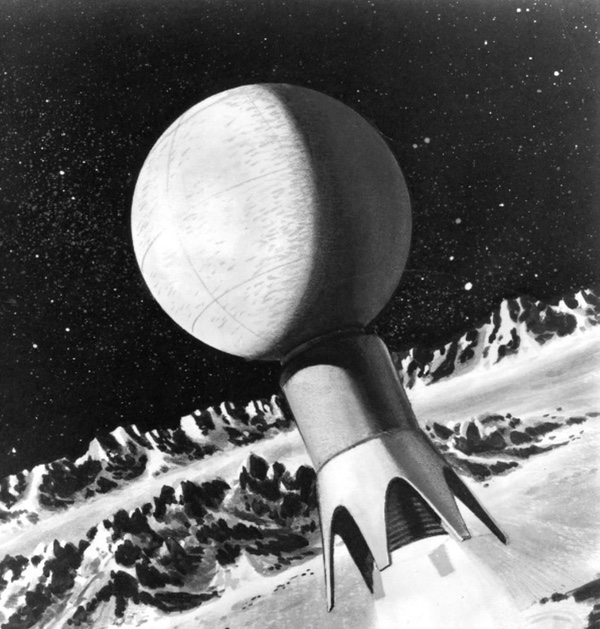 |
There are sparse details on the capabilities and design of these landing craft. The design of the small landers developed for the Ranger program may provide some insight. Outwardly, the Ranger landers resemble Probe 4 from the Recon LEM document. A small solid rocket motor (SRM) decelerates the probe, allowing it to survive a rough landing. After touchdown, its main task is a basic survey of the site, assessing its suitability for Apollo missions. Surveyor was designed to perform detailed measurements, but these simpler probes would serve as a backup for those more sophisticated soft landers.
| Early in the Apollo program, NASA planned to land an automated LEM on the Moon equipped with a TV camera to image its landing site. |
At this point in the Apollo program, there was an emphasis on the use of beacons to assist a Lunar Module. Since so little was known about the safety of the lunar surface, it seemed that the best plan would be to have landing aids emplaced on a certified site. When the LEM entered its final descent phase, it could home in on the signals generated by those devices. The circular error probability (CEP), i.e., targeting precision, of a descending LEM was a crucial factor in preparing for the first Apollo landing. The presence of a beacon would allow the Lunar Module to land within 100 feet (30 meters) of the center of a designated site.
The importance of beacons was evident at a meeting held to discuss landing aids that could be carried to the Moon by the Surveyor landers.[3] The subject was “the requirements and status of projects underway as they related to the landing aid problem.” A variety of options was discussed, including a Surveyor-deployed transponder. Active beacons as well as passive devices such as corner reflectors were also on the agenda. There was even consideration given to visual markers. These would be “visible during terminal phase and landing only; visible during terminal phase and landing as well as from lunar orbit; or visible during terminal phase and landing from lunar orbit as well as photographically from the unmanned Lunar Orbiter.”
The smallest probes carried by the Recon LEM may have had a very basic goal. The Grumman report stated “preliminary indications are that a relatively simple hard-lander with a beacon could perform an acceptable mission. The primary design problems would be in the areas of a survivable instrumentation and communication payload, and an adequate power supply for the beacon. However, these do not represent serious design problems, since hardware has already been developed in these areas (e.g., Ranger impact capsules and SNAP 3 plutonium radioisotope).” One option for a simple probe is seen in this illustration from a trade magazine of that era. It included an array of X-band antennas that would provide a radio beam detectable by the LEM rendezvous radar.
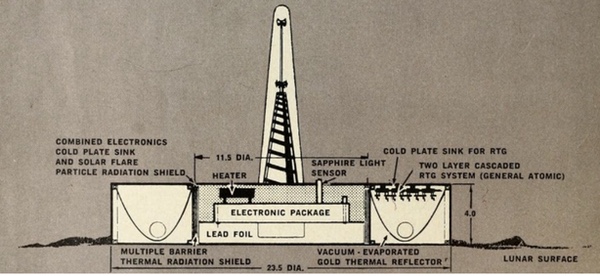 (credit: Missiles & Rockets) |
NASA interest in precursor probes continued up to 1965 when it studied the Lunar Survey Probe (LSP) concept. In response, Hughes Aircraft proposed using a modified Surveyor lander that could be deployed from an orbiting Apollo spacecraft.
Though not mentioned in the Grumman report, there were other ideas afloat at the time for non-imaging tasks for drop probes. In their Upward proposal to NASA, Eastman Kodak outlined what could be accomplished: “The crew can also take action of another sort; specifically, the placement of special devices on the lunar surface. Examples might be: explosive [charges], the effects of which could be photographed on impact with the surface or when radio controlled (detonation) was induced on a subsequent orbit, surface dyes whose rate of disappearance would be recorded, objects ejected from the satellite to mark the surface, or flares to illuminate polar valleys hidden from sunlight.”[2] Experiments of this type were to be deployed by a proposed series of advanced Lunar Orbiters.
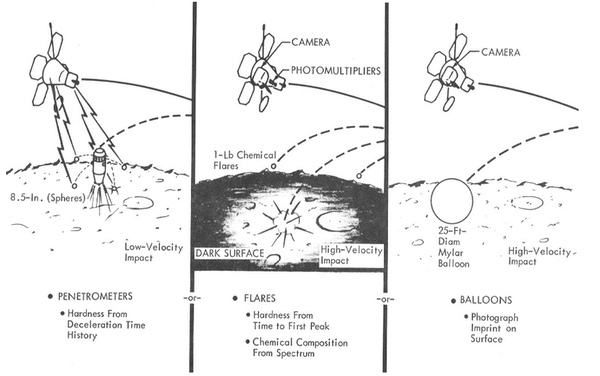 Lunar Impact Probes (credit: The Boeing Company) |
There was one more effort that might have provided ground truth. Early in the Apollo program, NASA planned to land an automated LEM on the Moon equipped with a TV camera to image its landing site (Aviation Week and Space Technology; Jan. 10, 1966, p.36). This concept was also mentioned in the NRO’s history of the Upward project.
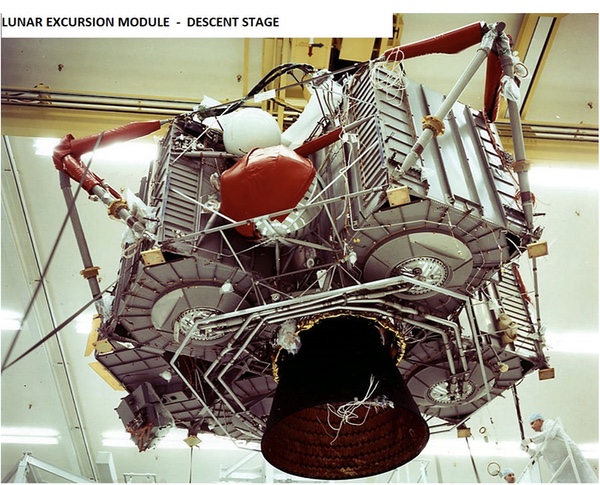 |
Barnstorming the Moon
The key to the Grumman proposal was the LEM’s ability to fly independently of the CSM. Its Descent Propulsion System (DPS) provided the necessary delta-V to adjust its orbit which, in turn, would allow a greater area of the Moon to be surveyed during a short stay in lunar orbit.
The main object of this precursor mission was to obtain site photographs as quickly as possible. When these missions were being formulated, there may have been an expectation that the hardware would not support missions that were longer than one week. Equally important as a mission objective was wide-area mapping of the near and far sides of the Moon. At that time, only the low-resolution photos from Luna 3 were available.
| The main object of this precursor mission was to obtain site photographs as quickly as possible. |
This excerpt from the Mission A game plan illustrates how each orbit was filled site reconnaissance, probe deployment, and orbital adjustments. The LEM (docked to the CSM) would first enter a circular, equatorial, 80-nautical-mile (148-kilometer) lunar orbit. After separating from the CSM, the Recon LEM’s mission would begin in earnest. To quote the Grumman report, “Proceeding step by step from here, elliptical (8-n. mi pericynthion) orbits are then interspersed with the mapping orbits for probe dropping and site-verification photography.” There were also large maneuvers to “crank” the orbit, i.e., change orbital inclination and line of nodes. That would allow the Recon LEM to survey a greater portion of the Moon’s surface during a short mission.
The six DPS burns designed to rotate the orbital inclination were significant maneuvers, with each involving a delta-V on the order of 500 feet per second (150 meters per second). By contrast, DPS burns to alter orbital altitude required a mere 25 feet per second (8 meters per second) of delta-V.
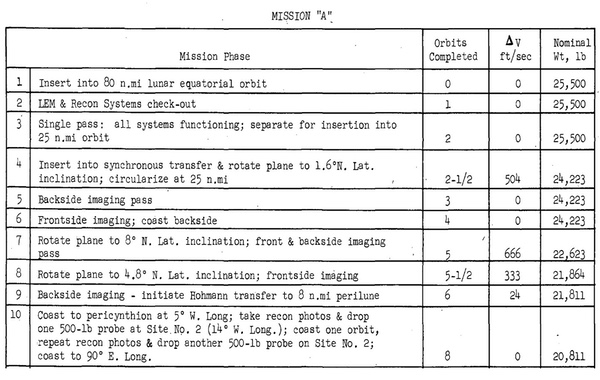 |
After five mapping orbits at 25 nautical miles (46 kilometers), the orbit was adjusted to begin photo surveys of candidate landing sites. During each low pass at eight nautical miles (15 kilometers), the Recon LEM would deploy one of the landing probes. After scouting Sites #1 and #2, the descent engine would again inject the LEM into a circular orbit of 25 nautical miles for more wide-area mapping of the Moon. Following that, it was back to a low-altitude orbit.
These maneuvers would burn a significant amount of fuel, an average of 2,500 pounds (1,130 kilograms) for each burn. By the end of its recon duties, the mass of the LEM would have decreased from an initial 25,500 pounds (11,600 kilograms) to a final 14,000 pounds (6,350 kilograms) before it jettisoned the descent stage. The total delta-V was 4,000 feet per second (1,200 meters per second), about 80% that of a lunar landing. Eight probes were to be dropped, each with a weight of 500 pounds (225 kilograms), for a total of 4,000 pounds (1,800 kilograms). Mission A would be complete after 20 orbits of the Moon.
There were also two shorter mission plans for the Recon LEM. Option B devoted most of its time to wide-area mapping of the Moon over the course of six orbits. After dropping the pericynthion to eight nautical miles, the Recon LEM would survey several landing sites during two more orbits. It would also drop a total of 7,000 pounds (3,200 kilograms) of probes, though the report does not list the types that were carried.
Plan C was the simplest of all, with photography and probe deployments completed in six orbits. The LEM would remain docked to the CSM while conducting wide-area mapping. Also, while docked, the DPS would be fired several times to change the orbital inclination. The LEM would then undock, quickly surveying landing sites and dropping 5,000 pounds (2,300 kilograms) of probes in the span of only two orbits.
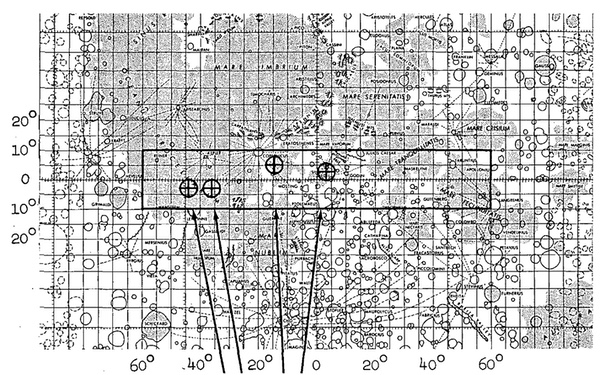 Recon LEM Survey Sites (Aeronautical Chart and Information Center; USAF) |
The LEM reconnaissance mission plan focused on four targets on the Moon in the equatorial Apollo zone. They are all located in the western sector of the near side, to be observed during the last quarter phase of the Moon. This timing was dictated by orbital dynamics as it would allow a daytime splashdown of the Command Module.
A few notes of interest. Site 4 became the target for the Surveyor 1 lander. Surveyors 2, 4, and 6 were all sent towards Site 1, with only Surveyor 6 succeeding. The area near that location became Apollo candidate site II-P-8 and was photographed by Lunar Orbiter 2. Those images give a good idea of the types of photographs that were to be returned by the LEM Recon mission.
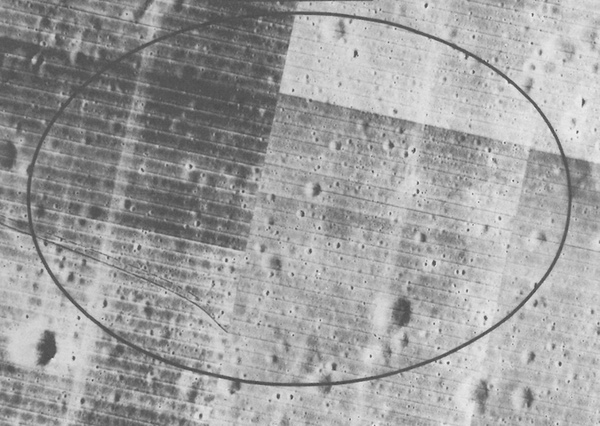 (credit: NASA) |
A panoramic camera was part of the Recon LEM’s payload. It would have provided a view similar to that facing a crew as they approached their landing site. This Lunar Orbiter mosaic of Site II-P-8 illustrates how such images from the Recon LEM would have looked.
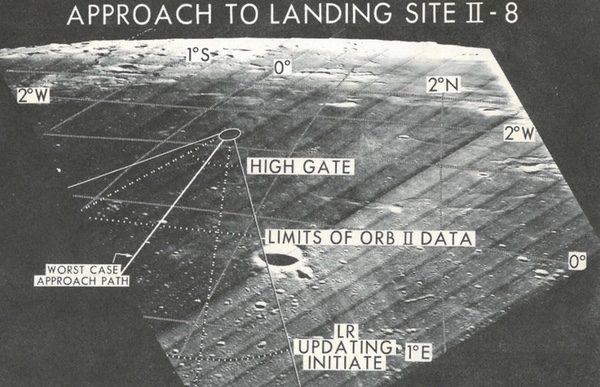 (credit: NASA) |
The LEM Recon never flew but NASA did go forward with the LMSS effort for several years. As mentioned, the LMSS utilized a modified Gambit satellite equipped with the classified KH-7 camera. This project, with the classified name of Upward, began in 1964 as a joint project between the NRO and NASA. It progressed to the point where two flight units were being prepped for vacuum tests. In the end, the robots came through and the LMSS was cancelled in July 1967.
| History is now repeating itself as NASA plans for missions to land robot avatars on ice moons such as Europa and Enceladus. |
The Apollo 10 mission resembled, in some small way, that of the Recon LEM. The Lunar Module Snoopy (LM-4) flew low over Site II-P-2 for a couple of orbits at an altitude of nine nautical miles (17 kilometers). Though brief, the orbital maneuvers of LM-4 demonstrated the agility of the craft, a key element of the Recon proposal.
History is now repeating itself as NASA plans for missions to land robot avatars on ice moons such as Europa and Enceladus. We have no idea of the small-scale nature of their surfaces and of the distribution of smooth terrain. High-resolution photo surveys and site certification probes, perhaps carrying beacons, seem to be logical precursors. I reviewed these options in a white paper for the most recent Planetary Decadal Survey, “Europa Exploration Philosophy.”
Sources
- “Grumman Study of LEM for Lunar Orbital Reconnaissance”; September 1963; Grumman Aircraft Engineering Corporation
- “Preliminary Engineering Description of the Survey Camera for the Apollo Mapping and Survey System,” Volume 1; prepared by Eastman Kodak Company, Apparatus and Optical Division for Headquarters Space Systems Division (SAFSP)
- “The Apollo Spacecraft – A Chronology”; NASA SP-4009; Brooks and Ertel; 1973; Volume III; entry for October 23, 1964
Philip Horzempa was a member of the Lunar Orbiter Image Recovery Project (LOIRP) and can be contacted via The Space Review.
Note: we are using a new commenting system, which may require you to create a new account.
The Starliner-Better Late Than Never
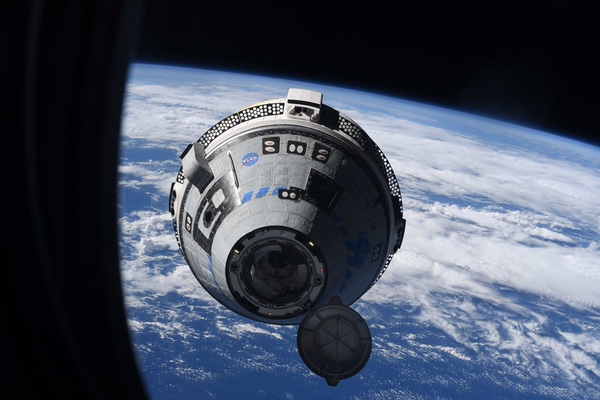 ESA astronaut Samantha Cristoforetti took this image of Starliner approaching the station just before its docking May 20. (credit: ESA/NASA) |
For Starliner, better late than never
by Jeff Foust
Monday, May 23, 2022
Two and a half year ago, Boeing and NASA were excited about the first uncrewed test flight of the company’s CST-100 Starliner commercial crew vehicle. The company pulled out all the stops for the Orbital Flight Test (OFT) mission for media at the Kennedy Space Center, erecting a large tent at the press site for briefings and other events in the days leading up to the launch and even showing off its “AstroVan II” it developed with Airstream to transport astronauts to the launch pad for later crewed flights.
| “We’re ready,” Wilmore said. “This spacecraft is ready. These teams are ready. Boeing is ready. ULA is ready… we’re excited.” |
Last week, the excitement of OFT was replaced by something closer to ennui for OFT-2. Boeing kept a low profile at the event, with no media tent and no AstroVan II. NASA wasn’t very excited either, it seemed: it didn’t start its live coverage of the launch on NASA TV until less than an hour before liftoff, and a “leadership media briefing” the day before had, as the highest-ranking agency official, associate administrator Bob Cabana (a similar briefing before last month’s SpaceX Crew-4 launch of astronauts included administrator Bill Nelson.) Media in general preferred to cover the launch from a distance, rather than at KSC.
That low profile reflects the disappointment in the progress Starliner has made in the last two and a half years. Just before OFT, the vehicle seemed not far behind SpaceX’s Crew Dragon, which flew its Demo-1 uncrewed mission to the station nine months earlier. With SpaceX subsequently losing that spacecraft in a ground test of its abort thrusters, there was still a shot that Boeing could get astronauts to the station ahead of SpaceX provided it had a clean test flight.
Boeing, of course, did not. An improperly set timer in the spacecraft caused the mission to go haywire immediately after being released from its Centaur upper stage. Starliner never made it to the space station on OFT, landing two days later (see “The year of commercial crew comes to an end, without crew,” The Space Review, December 23, 2019). Weeks later, NASA and Boeing disclosed they had to fix software on the spacecraft while it was in orbit to prevent the service module from bumping back into the crew capsule after separation, which could have jeopardized the capsule’s reentry.
Then came the first attempt to launch OFT-2 last summer, scrubbed just hours before liftoff when propellant valves in the service module failed to open (see “Starliner sidelined”, The Space Review, August 16, 2021). Engineers discovered that the valves had corroded shut, after nitrogen tetroxide seeped through Teflon seals of the valves and reacted with ambient moisture to create nitric acid. Boeing developed a series of short-term fixes—delaying the loading of nitrogen tetroxide and purging the valves with nitrogen gas to remove moisture—to keep it happening again, while not ruling out design changes to the valve itself down the road.
In the leadup to last week’s launch, Boeing officials said the believed they had fixed, at least for now, the valve problem and other issues with Starliner. Mark Nappi, vice president and commercial crew program manager at Boeing, noted that as part of the mitigations for the valve problem, controllers regularly cycled the valves to make sure they were moving as expected. “They’re working really well,” he said at one prelaunch briefing.
The NASA astronauts who have been training for years to fly on Starliner also exuded confidence. “We wouldn’t be here right now if we weren’t confident that this would be a successful mission,” said Butch Wilmore at a briefing the day before the launch, when asked how he felt about this launch attempt versus previous ones for Starliner.
“We’re ready,” he said. “This spacecraft is ready. These teams are ready. Boeing is ready. ULA is ready. The mission ops folks who will control the spacecraft in space are ready, and we’re excited.”
Helpfully, the weather was ready, too, and the Atlas 5 lifted off Thursday evening after a trouble-free countdown. A half-hour later, controllers confirmed that Starliner has performed its orbital insertion burn, suggesting that all was well as the spacecraft headed towards the ISS.
| “This was a really critical demonstration mission,” said Lueders. “Seeing that vehicle docked now to the ISS is just phenomenal.” |
Or, at least, mostly well. At a post-launch briefing a couple hours after liftoff, NASA and Boeing revealed that 2 of 12 aft-facing Orbital Maneuvering and Attitude Control (OMAC) thrusters shut down during the orbital insertion burn. Nappi said the first one shut down after just one second, and the spacecraft switched to a second thruster in the same pod, of “doghouse,” on the service module. That second thruster shut down 25 seconds later, but a third thruster in that pod took over for the remainder of the 40-second burn.
Other thrusters worked fine during the burn, and Nappi emphasized there was plenty of redundancy in the system to ensure both the success of that maneuver and others the thrusters would perform to bring the spacecraft into the vicinity of the station. “The system is designed to be redundant and it performed like it was supposed to,” he said. “Now the team is working the why, as to why we had those anomalies occur.”
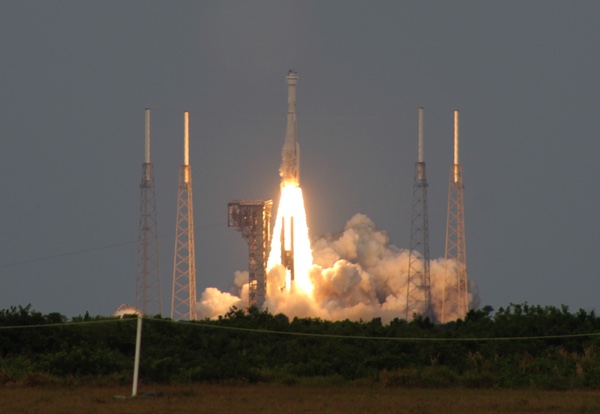 The Atlas 5 carrying Starliner lifts off May 19 from Cape Canaveral, as seen from the KSC Press Site. (credit: J. Foust) |
NASA and Boeing then went silent for nearly 18 hours, providing no updates as Starliner approached the station. The lack of news led to speculation that perhaps something had gone wrong with the mission, that perhaps the OMAC thruster problem was more serious than originally reported. A Boeing spokesperson contacted Friday morning about the status of the mission promised an update “in a bit,” but it was more than three hours before the company had anything more to say about the mission.
Boeing and NASA, it seemed, just didn’t have much to say when they finally broke their silence Friday afternoon, about four hours before the scheduled docking. The spacecraft was working well and performing maneuvers with those OMAC thrusters as well as smaller reaction control system (RCS) thrusters, and other systems were working well, the company said.
There were a few minor glitches during Starliner’s final approach to the station, such a software that had problems identifying the approaching spacecraft and a docking ring on the spacecraft that needed to be retracted and re-extended, the equivalent of turning it off and back on again. At 8:28 pm EDT Friday—a little more than an hour behind schedule—Starliner docked at last with the ISS.
In a call with reporters shortly after the docking, NASA officials expressed relief that Starliner finally made it. “This was a really critical demonstration mission,” said Kathy Lueders, NASA associate administrator for space operations. “Seeing that vehicle docked now to the ISS is just phenomenal.”
Nappi said that Boeing was still studying the failure of the two OMAC thrusters, having found “three or so” plausible explanations. The two thrusters, he added, might have failed for different reasons despite both being in the same doghouse.
“We may never know what the real cause of what this is because we don’t get this vehicle back,” he said. The thrusters are in the service module, which is jettisoned and burns up on reentry.
| “I had to wait a little longer for my birthday present,” said Stich. “I’m just thrilled to be here on my birthday welcoming the Starliner to the space station and watching that vehicle come in and dock.” |
In addition to the OMAC thrusters, two small RCS thrusters also failed on approach to the station. “I don’t think we know quite yet what happened to those thrusters, but the vehicle has plenty of redundancy,” said Steve Stich, NASA commercial crew program manager. The RCS thrusters will be used for undocking and moving away from the station, while the OMAC thrusters will be used for the deorbit burn.
He was pleased, though, that Starliner made it to the ISS successfully. “I had to wait a little longer for my birthday present. It was well worth the wait to have Starliner dock to the International Space Station,” said Stich, who celebrated his 57th birthday Friday. “I’m just thrilled to be here on my birthday welcoming the Starliner to the space station and watching that vehicle come in and dock.”
The OFT-2 mission is still far from over. On Saturday, ISS astronauts entered Starliner for the first time, conducting tests and transferring cargo: more than 200 kilograms of food and supplies for the station, and nearly 300 kilograms of equipment that will be heading back to Earth. Those hatches will close again as soon as Tuesday for a Wednesday undocking, reentry, and landing at White Sands, New Mexico, the same site as the original OFT touched down 29 months earlier.
Both NASA and Boeing were looking ahead, even before launch, to the next test flight, the Crew Flight Test (CFT) mission that will carry NASA astronauts for the first time. Nappi said the company believed it could have Starliner ready for that CFT mission by the end of the year, assuming no major issues on OFT-2.
NASA is not ready to commit to a date, or even a crew, for CFT. “We’re going to take this one step at a time,” Lueders said at a prelaunch briefing. That schedule, and the crew assignments, would depend on several factors, including the readiness of the spacecraft and the status of activities on the ISS.
She said she would coordinate with Reid Wiseman, NASA chief astronaut, on deciding who would fly CFT and how long that mission will last, as well as the timing for PCM-1, the first operational Starliner mission. “We’ll be looking at final CFT and PCM-1 timelines this summer, and then we’ll be making final crew selections for the [ISS] increments coming up and for CFT.”
“But we’ve got to get through this demo first,” she added.
Once Starliner is certified, NASA envisions alternating ISS missions with Crew Dragon, which is already on its fourth operational ISS mission and seventh overall crewed mission, counting Demo-2 and two private astronaut missions. That would mean flying Starliner once a year for NASA, stretching out its contract of six operational missions into the late 2020s.
The problem is that ULA is planning to retire the Atlas 5 before then as it transitions to the Vulcan Centaur. Some, including NASA’s own Aerospace Safety Advisory Panel, raised concerns about that transition and human-rating the Vulcan.
| “We’re focused first and foremost on getting safely back to flight and meeting our commitments to NASA, to our customer, and being able to bring this capability to NASA,” said Parker. “We expect there will be additional opportunities in the future.” |
ULA says it plans to keep Atlas 5 in service for Boeing for the length of its current contract. “From a resource perspective, we have measures in place to protect the talent and to ensure we retain the critical skills to be able to fly an Atlas as late as we need to,” said Gary Wentz, vice president of government and commercial programs at ULA. “We’re in conversations with Boeing and other customers for that capability.”
It's unclear how that might affect other commercial users of Starliner—if there are any. Boeing has not announced any firm contracts for Starliner outside its NASA agreement. Boeing, since the OFT mission, has taken nearly $600 million in charges against its earnings to cover the work needed for OFT-2.
“We’re focused first and foremost on getting safely back to flight and meeting our commitments to NASA, to our customer, and being able to bring this capability to NASA,” Michelle Parker, vice president and deputy general manager of space and launch at Boeing, said before the launch when asked about the business case for the spacecraft. She noted Starliner is one Boeing contribution to the Orbital Reef commercial space station project led by Blue Origin. “We expect there will be additional opportunities in the future.”
Those missions, though, will likely require certifying Vulcan or another rocket for Starliner, as would any additional ISS missions between the end of Boeing’s current contract and the retirement of the station in 2030. NASA’s Stich said the agency would support human-rating a new rocket for Starliner “when Boeing and ULA are ready.”
That’s still a long way off, particularly since OFT-2 is far from over. After all the delays, it’s easy to see why the overwhelming mood about the launch and docking has been one not of exuberance but of relief, of achieving a milestone that had been a millstone for so long.
Jeff Foust (jeff@thespacereview.com) is the editor and publisher of The Space Review, and a senior staff writer with SpaceNews. He also operates the Spacetoday.net web site. Views and opinions expressed in this article are those of the author alone.
Note: we are using a new commenting system, which may require you to create a new account.
Thursday, May 26, 2022
Wednesday, May 25, 2022
Plants Can Grow On The Moon
Moon Blooms
Plants can grow on the moon but some tinkering is needed for vegetation to thrive, according to a new study on lunar soil.
University of Florida researchers recently grew small plants using lunar rock and soil samples taken from the Apollo missions decades ago, the Washington Post reported.
NASA provided the research team with 12 grams of soil – four each from the Apollo 11, 12 and 17 missions – which had never been exposed to Earth’s atmosphere or water.
The team tried to plant seeds of the fast-growing thale cress but found that the samples were extremely hydrophobic – they repelled water – and lacked nutrients. To resolve this, they combined the extraterrestrial soil with a nutrient solution.
The plants then germinated and began to sprout leaves even though some of them struggled: Plants planted in samples collected from the Apollo 11 mission had the toughest time growing, for example.
Even though they were edible, the researchers noted that the plants disliked lunar soil and their roots turned out “more bent and gnarly.”
Still, the authors concluded that while lunar soil is “not a benign growth substrate,” it could still be used by astronauts in the future to attempt plant production on the moon, even though it would require a lot of work due to its lack of numerous minerals found on earth.
“I think it’s amazing that the plant still grew,” co-author Robert Ferl said. “Right, it’s stressed, but it doesn’t die. It doesn’t fail to grow at all. It adapts.”
Tuesday, May 24, 2022
Is The Boeing Starliner Spacecraft "A Flying Coffin" For Astronauts?
The Boeing Company started life in 1916 in Seattle. In World War II, my Uncle John Robert commanded a B-17. He survived his 26 combat missions over German. Crews of these planes marveled at the ruggedness and dependability of these planes.
After World War II, Boeing produced the
B-47 bomber and B-52 bomber. The B-52 is still in service and could make 100
years of service. Boeing also produced incredible airliners that one could find
in airlines all over the world.
Boeing was a company that was run by
engineers. Then the company merged with McDonald Douglas. Finance executives
started to replace engineers in senior management positions. What followed were
nightmares like the 737 crashes and the failures associated with the Starliner
manned spacecraft. Boeing was given a $400 million US contract to build this
spacecraft. The spacecraft finally made it to the International Space Station.
It will separate and make its reentry later today. You know that old saying
about "a day late and a dollar short." The Starliner had a systems
failure on the way to the I.S.S. concerning thrusters. The Angry Astronaut is
warning everyone that the spacecraft is not ready to carry astronauts. NASA is
not listening to him.
When returning from New Orleans, I found
myself seated next to a 56-year-old United Airlines senior captain named Dave.
He was getting a free ride to his home in San Diego. He gave me a fascinating
briefing on the various airlines that he had flown during his career spanning
17,000 hours in the air.
He gave me a startling revelation
about the 737-software disaster. I commented that United was wise to buy 737s
with two sensors whereas the airlines that bought 737s with one sensor
experienced crashes.